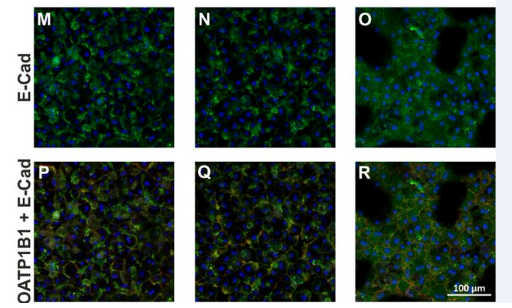Optimization of extracellular matrix for primary human hepatocyte cultures using mixed collagen-matrigel matrices
DOI:
https://doi.org/10.17179/excli2022-5459Keywords:
in vitro liver models, primary human hepatocytes, extracellular matrix, collagen, Matrigel, sandwich cultureAbstract
Loss of differentiation of primary human hepatocytes (PHHs) ex vivo is a known problem of in vitro liver models. Culture optimizations using collagen type I and Matrigel reduce the dedifferentiation process but are not able to prevent it. While neither of these extracellular matrices (ECMs) on their own correspond to the authentic hepatic ECM, a combination of them could more closely resemble the in vivo situation. Our study aimed to systematically analyze the influence of mixed matrices composed of collagen type I and Matrigel on the maintenance and reestablishment of hepatic functions. Therefore, PHHs were cultured on mixed collagen-Matrigel matrices in monolayer and sandwich cultures and viability, metabolic capacity, differentiation markers, cellular arrangement and the cells’ ability to repolarize and form functional bile canaliculi were assessed by reverse transcription quantitative real-time polymerase chain reaction (RT-qPCR), functional assays and immunofluorescence microscopy. Our results show that mixed matrices were superior to pure matrices in maintaining metabolic capacity and hepatic differentiation. In contrast, Matrigel supplementation can impair the development of a proper hepatocytic polarization. Our systematic study helps to compose an optimized ECM to maintain and reestablish hepatic differentiation on cellular and multicellular levels in human liver models.

Downloads
Additional Files
Published
How to Cite
License
Copyright (c) 2023 Lena Seidemann, Sarah Prinz, Jan-Constantin Scherbel, Christina Götz, Daniel Seehofer, Georg Damm

This work is licensed under a Creative Commons Attribution 4.0 International License.
Authors who publish in this journal agree to the following terms:
- The authors keep the copyright and grant the journal the right of first publication under the terms of the Creative Commons Attribution license, CC BY 4.0. This licencse permits unrestricted use, distribution and reproduction in any medium, provided that the original work is properly cited.
- The use of general descriptive names, trade names, trademarks, and so forth in this publication, even if not specifically identified, does not imply that these names are not protected by the relevant laws and regulations.
- Because the advice and information in this journal are believed to be true and accurate at the time of publication, neither the authors, the editors, nor the publisher accept any legal responsibility for any errors or omissions presented in the publication. The publisher makes no guarantee, express or implied, with respect to the material contained herein.
- The authors can enter into additional contracts for the non-exclusive distribution of the journal's published version by citing the initial publication in this journal (e.g. publishing in an institutional repository or in a book).





